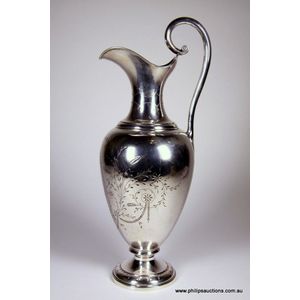Flow Blue Iris Porcelain Vase with Gilded Accents
You must be a subscriber, and be logged in to view price and dealer details.
Subscribe Now to view actual auction price for this item
When you subscribe, you have the option of setting the currency in which to display prices to $Au, $US, $NZ or Stg.
- Gilding - Gilding is a method of ornamentation whereby a thin sheet of gold metal is applied to items made of wood, leather, ceramics, glass and silver for decorative purposes.
For furniture including mirrors, the sheet of gold is usually applied over a coating of gesso. Gesso is a mixture of plaster of Paris and gypsum mixed with water and then applied to the carved wooden frames of mirrors and picture frames as a base for applying the gold leaf. After numerous coats of gesso have been applied, allowed to dry and then sanded a coat of "bole", a usually red coloured mixture of clay and glue is brushed on and allowed to dry, after which the gold leaf is applied. Over time parts of the gilding will rub off so the base colour can be seen. In water gilding, this was generally a blue colour, while in oil gilding, the under layer was often yellow. In Victorian times, gilders frequently used red as a pigment beneath the gold leaf.
Metal was often gilded by a process known as fire gilding. Gold mixed with mercury was applied and heated, causing the mercury to evaporate, the long-term effect of which was to kill or disable the craftsman or woman from mercury poisoning. The pursuit of beauty has claimed many victims, not the least of which were the artists who made those pieces so highly sought after today. - Flow Blue - Ceramics decorated in deep cobalt blue and white where the colour change is blurred, giving the effect of blue watercolour applied on top of wet white watercolour. Manufacture using this technique commenced in the Saffordshire area of Britain about 1820 and continued for a 100 years, by potteries such as Wedgwood, Johnson Brothers, Minton, Royal Doulton, and Swansea.
This item has been included into following indexes:
-
Royal Doulton (England), item types
- ovoid and baluster shaped vases 1,556
- vases, other 770
Visually similar items

A George III silver claret jug, vase shaped with gadrooned rim and border, domed hinged lid with acorn finial, cane bound handle (distressed). London 1775 by Louisa Cortauld and George Cowles. 630gms. Height 30 cm

A Victorian Grecian style sterling silver wine ewer, 1853 London, with maker's mark for Joseph and Albert Savory, the neoclassical style ewer with a baluster body and a slender waisted neck surmounted by an unusual looped pouring spout having an exaggerate

A Coalport vase painted by Arthur Bowdler, late 19th century, decoration pattern V7251, registration number 283672, of classical baluster shape with a shaped pouring lip and foliate scrolling handle, a reserve to one side of the body painted with various f

A fine Danish .826 silver wine ewer, circa 1888 with three towers mark, maker's mark of Peter Hertz, assay master mark of Simon Groth, of elegant baluster form with a waisted collar and shaped pouring rim, a high set scrolling handle and a pedestal base, d
